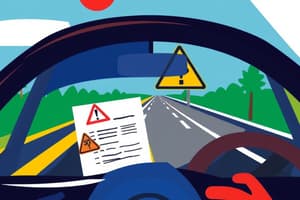Podcast
Questions and Answers
Approximately how long does it take a new driver to reach the driving ability of the average experienced driver?
Approximately how long does it take a new driver to reach the driving ability of the average experienced driver?
- 5 years (correct)
- 1 year
- The length of a driver education course
- Six months
Approximately what percent of crashes are caused by driver error?
Approximately what percent of crashes are caused by driver error?
- 90 (correct)
- 63
- 39
- 55
Successfully completing a driver education course will guarantee that you become a safe driver.
Successfully completing a driver education course will guarantee that you become a safe driver.
False (B)
To enhance your ability to assess and manage risk in specific driving situations, you should:
To enhance your ability to assess and manage risk in specific driving situations, you should:
Drivers who are unaware of the risk involved in driving will tend to:
Drivers who are unaware of the risk involved in driving will tend to:
Nearly half of all new drivers will either be convicted of a traffic offense or be involved in a collision during their first 12 months of driving.
Nearly half of all new drivers will either be convicted of a traffic offense or be involved in a collision during their first 12 months of driving.
Overestimating your ability to assess traffic or roadway conditions can result in:
Overestimating your ability to assess traffic or roadway conditions can result in:
Graduated Driver License programs generally involve ______ stages?
Graduated Driver License programs generally involve ______ stages?
Parents should work as a team with a driving instructor to provide practice for the new driver.
Parents should work as a team with a driving instructor to provide practice for the new driver.
Which of the following presents the greatest advantage of a Parent-Teen Driving Agreement?
Which of the following presents the greatest advantage of a Parent-Teen Driving Agreement?
Graduated Driver Licensing Programs generally include which of the following?
Graduated Driver Licensing Programs generally include which of the following?
When you adjust your side mirrors, position your head straight ahead as if you were driving.
When you adjust your side mirrors, position your head straight ahead as if you were driving.
How often should the pre-driving checks identified for approaching the vehicle, outside the vehicle, and inside be performed?
How often should the pre-driving checks identified for approaching the vehicle, outside the vehicle, and inside be performed?
When approaching your vehicle parked at a curb, you should:
When approaching your vehicle parked at a curb, you should:
When conducting outside-the-vehicle checks, you should inspect your:
When conducting outside-the-vehicle checks, you should inspect your:
Under normal driving conditions, checks under the hood should be performed how often?
Under normal driving conditions, checks under the hood should be performed how often?
Which of these is not part of a daily pre-driving check?
Which of these is not part of a daily pre-driving check?
Seatbelts help keep a driver behind the steering wheel and in control during a crash.
Seatbelts help keep a driver behind the steering wheel and in control during a crash.
If you put groceries in your vehicle, they should be:
If you put groceries in your vehicle, they should be:
Flashcards
New Driver Skill Development
New Driver Skill Development
New drivers take approximately 5 years to develop experienced driving skills.
Cause of Most Crashes
Cause of Most Crashes
90% of vehicle crashes are caused by driver error. This includes mistakes and poor decisions.
Risk Management While Driving
Risk Management While Driving
Effective risk management while driving includes anticipating danger, preparing to react, and considering consequences.
Risk Recognition
Risk Recognition
Signup and view all the flashcards
New Driver Incident Rate
New Driver Incident Rate
Signup and view all the flashcards
Overestimating Driving Skills
Overestimating Driving Skills
Signup and view all the flashcards
GDL Restrictions
GDL Restrictions
Signup and view all the flashcards
Parent-Instructor Collaboration
Parent-Instructor Collaboration
Signup and view all the flashcards
Parent-Teen Driving Agreements
Parent-Teen Driving Agreements
Signup and view all the flashcards
Frequency of Vehicle Checks
Frequency of Vehicle Checks
Signup and view all the flashcards
Approaching Parked Vehicles
Approaching Parked Vehicles
Signup and view all the flashcards
Checking Headlights
Checking Headlights
Signup and view all the flashcards
Regular Under-Hood Checks
Regular Under-Hood Checks
Signup and view all the flashcards
Importance of Seatbelts
Importance of Seatbelts
Signup and view all the flashcards
Securing Groceries
Securing Groceries
Signup and view all the flashcards
Study Notes
Driver Education and Safety
- New drivers typically take about 5 years to reach the driving ability of an average experienced driver.
- A staggering 90% of crashes are attributed to driver error.
- Completing a driver education course does not guarantee safety as a driver.
Risk Management and Awareness
- Effective risk management in driving involves: anticipating dangerous situations, preparing to act, and considering the consequences of actions.
- Drivers who do not recognize driving risks are likely to claim that accidents are not their fault.
New Driver Challenges
- Almost half of all new drivers will be convicted of a traffic offense or involved in a collision within their first year of driving.
- Overestimating driving skills can lead to delayed, inappropriate, or no response to traffic situations.
Graduated Driver Licensing (GDL)
- GDL programs consist of 3 stages to gradually increase driving privileges.
- These programs typically enforce nighttime driving restrictions, require supervised practice driving, and place limits on passengers.
Parental Involvement
- Collaboration between parents and driving instructors is crucial for effective new driver practice.
- A Parent-Teen Driving Agreement facilitates clear communication about vehicle use and responsibilities.
Pre-Driving Procedures
- Pre-driving checks should be conducted each time the vehicle is used for safety reasons.
- When approaching a parked vehicle, it is safest to face oncoming traffic while approaching the driver’s door.
Vehicle Checks
- During outside-the-vehicle checks, drivers should inspect headlights to ensure proper function.
- Regular under-hood checks are advised at least once a month as per the vehicle owner's manual.
Seatbelt Safety
- Seatbelts are vital as they keep drivers secured and in control during a crash, significantly enhancing safety.
Vehicle Loading Safety
- Groceries should always be stored in the trunk or secured with a cargo net to prevent injury and distractions while driving.
Studying That Suits You
Use AI to generate personalized quizzes and flashcards to suit your learning preferences.




